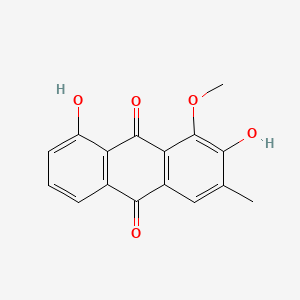Obtusifolin
PubChem CID
3083575
Chemical Safety
Molecular Formula
Synonyms
- Obtusifolin
- 477-85-0
- Obtusifolin (anthraquinone)
- 2,8-dihydroxy-1-methoxy-3-methylanthracene-9,10-dione
- 2,8-Dihydroxy-1-methoxy-3-methyl-9,10-anthracenedione
Molecular Weight
284.26 g/mol
Computed by PubChem 2.2 (PubChem release 2021.10.14)
Dates
- Create:2005-08-09
- Modify:2025-01-11
Description
Obtusifolin is a dihydroxyanthraquinone.
Obtusifolin has been reported in Senna obtusifolia and Senna tora with data available.
Chemical Structure Depiction

2,8-dihydroxy-1-methoxy-3-methylanthracene-9,10-dione
Computed by Lexichem TK 2.7.0 (PubChem release 2021.10.14)
InChI=1S/C16H12O5/c1-7-6-9-12(16(21-2)13(7)18)15(20)11-8(14(9)19)4-3-5-10(11)17/h3-6,17-18H,1-2H3
Computed by InChI 1.0.6 (PubChem release 2021.10.14)
NYRXUBDGDSRBGB-UHFFFAOYSA-N
Computed by InChI 1.0.6 (PubChem release 2021.10.14)
CC1=CC2=C(C(=C1O)OC)C(=O)C3=C(C2=O)C=CC=C3O
Computed by OEChem 2.3.0 (PubChem release 2024.12.12)
C16H12O5
Computed by PubChem 2.2 (PubChem release 2021.10.14)
111-899-5
obtusifolin
- Obtusifolin
- 477-85-0
- Obtusifolin (anthraquinone)
- 2,8-dihydroxy-1-methoxy-3-methylanthracene-9,10-dione
- 2,8-Dihydroxy-1-methoxy-3-methyl-9,10-anthracenedione
- Anthraquinone, 2,8-dihydroxy-1-methoxy-3-methyl-
- 9,10-Anthracenedione, 2,8-dihydroxy-1-methoxy-3-methyl-
- CHEBI:80880
- DTXSID70197254
- MFCD18452296
- Obtusifolin (Standard)
- CHEMBL448400
- SCHEMBL3171011
- HY-N2098R
- DTXCID80119745
- HY-N2098
- s9198
- AKOS037514758
- CCG-267293
- MS-24039
- XO171108
- CS-0018619
- C17039
- Q27151380
- 2,8-DIHYDROXY-1-METHOXY-3-METHYL-9,10-DIHYDROANTHRACENE-9,10-DIONE
Property Name
Property Value
Reference
Property Name
Molecular Weight
Property Value
284.26 g/mol
Reference
Computed by PubChem 2.2 (PubChem release 2021.10.14)
Property Name
XLogP3-AA
Property Value
3
Reference
Computed by XLogP3 3.0 (PubChem release 2021.10.14)
Property Name
Hydrogen Bond Donor Count
Property Value
2
Reference
Computed by Cactvs 3.4.8.18 (PubChem release 2021.10.14)
Property Name
Hydrogen Bond Acceptor Count
Property Value
5
Reference
Computed by Cactvs 3.4.8.18 (PubChem release 2021.10.14)
Property Name
Rotatable Bond Count
Property Value
1
Reference
Computed by Cactvs 3.4.8.18 (PubChem release 2021.10.14)
Property Name
Exact Mass
Property Value
284.06847348 Da
Reference
Computed by PubChem 2.2 (PubChem release 2021.10.14)
Property Name
Monoisotopic Mass
Property Value
284.06847348 Da
Reference
Computed by PubChem 2.2 (PubChem release 2021.10.14)
Property Name
Topological Polar Surface Area
Property Value
83.8 Ų
Reference
Computed by Cactvs 3.4.8.18 (PubChem release 2021.10.14)
Property Name
Heavy Atom Count
Property Value
21
Reference
Computed by PubChem
Property Name
Formal Charge
Property Value
0
Reference
Computed by PubChem
Property Name
Complexity
Property Value
448
Reference
Computed by Cactvs 3.4.8.18 (PubChem release 2021.10.14)
Property Name
Isotope Atom Count
Property Value
0
Reference
Computed by PubChem
Property Name
Defined Atom Stereocenter Count
Property Value
0
Reference
Computed by PubChem
Property Name
Undefined Atom Stereocenter Count
Property Value
0
Reference
Computed by PubChem
Property Name
Defined Bond Stereocenter Count
Property Value
0
Reference
Computed by PubChem
Property Name
Undefined Bond Stereocenter Count
Property Value
0
Reference
Computed by PubChem
Property Name
Covalently-Bonded Unit Count
Property Value
1
Reference
Computed by PubChem
Property Name
Compound Is Canonicalized
Property Value
Yes
Reference
Computed by PubChem (release 2021.10.14)
Follow these links to do a live 2D search or do a live 3D search for this compound, sorted by annotation score. This section is deprecated (see here for details), but these live search links provide equivalent functionality to the table that was previously shown here.
Mixtures, Components, and Neutralized Forms Count
Similar Compounds (2D)
Similar Conformers (3D)
Pictogram(s)

Signal
Warning
GHS Hazard Statements
H302 (100%): Harmful if swallowed [Warning Acute toxicity, oral]
Precautionary Statement Codes
P264, P270, P301+P317, P330, and P501
(The corresponding statement to each P-code can be found at the GHS Classification page.)
ECHA C&L Notifications Summary
The GHS information provided by 1 company from 1 notification to the ECHA C&L Inventory.
Acute Tox. 4 (100%)
Patents are available for this chemical structure:
https://patentscope.wipo.int/search/en/result.jsf?inchikey=NYRXUBDGDSRBGB-UHFFFAOYSA-N
The LOTUS Initiative for Open Natural Products Research: frozen dataset union wikidata (with metadata) | DOI:10.5281/zenodo.5794106
- CAS Common ChemistryLICENSEThe data from CAS Common Chemistry is provided under a CC-BY-NC 4.0 license, unless otherwise stated.https://creativecommons.org/licenses/by-nc/4.0/
- ChemIDplusChemIDplus Chemical Information Classificationhttps://pubchem.ncbi.nlm.nih.gov/source/ChemIDplus
- EPA DSSToxCompTox Chemicals Dashboard Chemical Listshttps://comptox.epa.gov/dashboard/chemical-lists/
- European Chemicals Agency (ECHA)LICENSEUse of the information, documents and data from the ECHA website is subject to the terms and conditions of this Legal Notice, and subject to other binding limitations provided for under applicable law, the information, documents and data made available on the ECHA website may be reproduced, distributed and/or used, totally or in part, for non-commercial purposes provided that ECHA is acknowledged as the source: "Source: European Chemicals Agency, http://echa.europa.eu/". Such acknowledgement must be included in each copy of the material. ECHA permits and encourages organisations and individuals to create links to the ECHA website under the following cumulative conditions: Links can only be made to webpages that provide a link to the Legal Notice page.https://echa.europa.eu/web/guest/legal-notice2,8-Dihydroxy-1-methoxy-3-methyl-9,10-anthraquinonehttps://echa.europa.eu2,8-Dihydroxy-1-methoxy-3-methyl-9,10-anthraquinone (EC: 111-899-5)https://echa.europa.eu/information-on-chemicals/cl-inventory-database/-/discli/details/397906
- ChEBI
- LOTUS - the natural products occurrence databaseLICENSEThe code for LOTUS is released under the GNU General Public License v3.0.https://lotus.nprod.net/Obtusifolinhttps://www.wikidata.org/wiki/Q27151380LOTUS Treehttps://lotus.naturalproducts.net/
- ChEMBLLICENSEAccess to the web interface of ChEMBL is made under the EBI's Terms of Use (http://www.ebi.ac.uk/Information/termsofuse.html). The ChEMBL data is made available on a Creative Commons Attribution-Share Alike 3.0 Unported License (http://creativecommons.org/licenses/by-sa/3.0/).http://www.ebi.ac.uk/Information/termsofuse.htmlChEMBL Protein Target Treehttps://www.ebi.ac.uk/chembl/g/#browse/targets
- Comparative Toxicogenomics Database (CTD)LICENSEIt is to be used only for research and educational purposes. Any reproduction or use for commercial purpose is prohibited without the prior express written permission of NC State University.http://ctdbase.org/about/legal.jsp
- Human Metabolome Database (HMDB)LICENSEHMDB is offered to the public as a freely available resource. Use and re-distribution of the data, in whole or in part, for commercial purposes requires explicit permission of the authors and explicit acknowledgment of the source material (HMDB) and the original publication (see the HMDB citing page). We ask that users who download significant portions of the database cite the HMDB paper in any resulting publications.http://www.hmdb.ca/citingObtusifolinhttp://www.hmdb.ca/metabolites/HMDB0255882
- Japan Chemical Substance Dictionary (Nikkaji)
- KEGGLICENSEAcademic users may freely use the KEGG website. Non-academic use of KEGG generally requires a commercial licensehttps://www.kegg.jp/kegg/legal.htmlPhytochemical compoundshttp://www.genome.jp/kegg-bin/get_htext?br08003.keg
- Natural Product Activity and Species Source (NPASS)
- Metabolomics Workbench
- Springer Nature
- WikidataObtusifolinhttps://www.wikidata.org/wiki/Q27151380
- PubChem
- Medical Subject Headings (MeSH)LICENSEWorks produced by the U.S. government are not subject to copyright protection in the United States. Any such works found on National Library of Medicine (NLM) Web sites may be freely used or reproduced without permission in the U.S.https://www.nlm.nih.gov/copyright.htmlobtusifolinhttps://www.ncbi.nlm.nih.gov/mesh/67546709
- MolGenieMolGenie Organic Chemistry Ontologyhttps://github.com/MolGenie/ontology/
- PATENTSCOPE (WIPO)SID 389241176https://pubchem.ncbi.nlm.nih.gov/substance/389241176
CONTENTS

